Fine Judaica Auction
Judaica Auctions and the exhibition that precede them at Kestenbaum & Company are always a cornucopia of aesthetic delights. The sheer variety and overall quality of the ceremonial objects and works of art make the exhibition and catalogue a museum-like experience. The current exhibition from June 16 through June 19th is no exception.
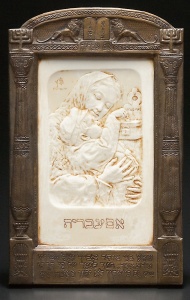
While Kestenbaum is normally known for rare books and manuscripts, this sale is devoted to Judaica ceremonial art; specializing in ceremonial objects such as kiddush cups, spice containers, ceremonial plates, menorahs, esrog containers, Torah pointers, finials and crowns. Additionally there are a variety of objects from the Bezalel School, Megillot, Kethubos, photographs and fine and graphic art. While within each category there are notable gems, space limits me to mention only a handful of objects that demand attention.
Boris Schatz, artist and founder of the Bezalel School in Jerusalem, was a visionary who attempted to create the first modern Jewish Art movement in Palestine in 1906. After preliminary art studies in Vilnius, Warsaw and Paris and the beginning of a successful career, he met Theodor Herzl and became transformed by Zionism, quickly dedicating himself to making a Jewish national art. While he also did painting, much of his work was in the form of relief sculptures in various mediums, including carved ivory.
The carved ivory (catalogue 131) Jewish Mother (ca. 1906), is extraordinary in both its size and subject. Measuring 6.25” X 3.85” it is the largest known ivory plaque by Schatz. This size allowed the artist to develop much fine detail that would be impossible with the more common Schatz plaques one third the size. His liberal use of the surface to effectively frame the image and supply its title in Hebrew further creates the impression of an expansive subject. And that is exactly reflected in the image of a young mother holding a child up to put a coin in the tzedakah box for the Meir Ba’al Haness charity. The concentration of the little boy’s face, echoed by the love and care of the young mother perfectly reflects the verse from Proverbs 1:8; “Listen, my son to your father’s instruction and do not forsake your mother’s teaching…” and 22:6 “educate your child onto the right path and even when he is old he will not depart from it,” inscribed on the frame, almost certainly designed by Ze’ev Raban. Schatz is declaring that one of the fundamental values of Jewish thought that we must transmit to our children is reaching out to help our fellows. The mitzvah of Tzedakah is a foundation of Judaism.
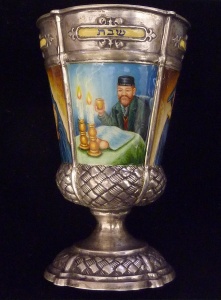
Schatz’s sophisticated and elegant image is contrasted with a delightful work of folk art, a German silver and enamel Kiddush goblet (catalogue 6). This Kiddush cup is graced with four enamel panels illustrating occasions the Kiddush cup is used: Rosh HaShanna; a man holding a shofar aptly labeled “Tekiah;” Passover; a curiously crowned individual seated at a table holds up a round matzah; Succos features a standing man in profile holding a lulav and esrog, and finally Shabbos that shows a seated individual about to recite the Kiddush over two loaves and before two oversized burning candles. These works are original folk images that stem from the personal experience of the artist himself, expressing an extraordinary sincerity and awkward veracity.
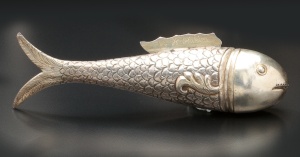
Among the twenty or so spice containers, including many fine examples of the familiar Medieval Tower and flower-form, there rests a lone fish. While this fish-form is not especially rare, this silver filigree spice container (catalogue 29) is particularly charming. The piece, inscribed “R.H.. Hakim” on one side of the fin and 3-12-1912 on the other, finely details scales from neck to tail where the incised silver changes direction to articulate a graceful finish. Its smooth head features a simple small mouth and wide-open eyes, echoing the notion from the Talmud (Sotah 36b) that fish are immune from the evil eye since they are shielded under water. This kind of protection from the evil eye is of course the perfect beginning to the new week that Havdalah inaugurates. Additionally the fish is a symbol of fertility from Jacob’s blessing to Ephraim and Manasseh (Genesis 48:16) “…and may they reproduce abundantly like fish within the land,” which surely prophesies a fruitful week to come.
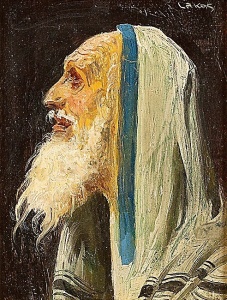
The utilization of Jewish symbols from Tanach and Talmud in Judaica is one of the primary methods of generating meaning in what are simply ceremonial ritual objects. These visual symbols can lead us into a heady mystical universe. A diminutive painting by Alfred Lakos, (catalogue 197) In Prayer also inhabits a mystical realm. Lakos (1870-1961) was born near Budapest and studied art in Budapest, Munich and Paris. He began his career creating caricatures for journals and magazines to fight the ubiquitous anti-Semitism of his time. Later he turned to painting Jewish genre themes including Mourning Jews, Shabbos Rest, The Bocher and Pogrom Victims and even Biblical figures, particularly the matriarch Rachel. Not surprisingly his work features many pietistic depictions of Jews and/or Rabbis in prayer. In what began as a criticism of his work, author and noted Hungarian Zionist Joseph Patai declared in 1916 that; ”For twenty years he has been a painter for the emancipation of the Jewish theme. To say it with biblical words, these themes are flesh from his flesh and bones from his bones – the redemption of the wandering Jews from the galut. Art for Lakos is not l’art pour l’art, but means for a higher purpose…the strongest weapon in the fight against hatred and lies and inhumanity.”
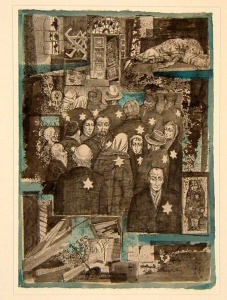
In Prayer at first seems like many of Lakos’s profiles of old Jews. All of the elements of the formula are in place; the white beard, aged wrinkles and tallis over his balding head. But upon close inspection there is a freedom and joy in the paint application, one that goes well beyond mere description and begins to approach a mystical animation both on the surface and in the paint itself. While we don’t know what year this was painted in, it betrays a decidedly modernist quality. The blue stripe of the atarah is starkly centered in the painting, neatly dividing the image: the pleading otherworldly profile on one side and the mountain-like folds of the tallis on the other. This individual is more than seen in prayer, he is mounted in another universe.
Easily the most extraordinary artwork in the Kestenbaum auction is the complete suite of 40 gouache, pen and ink paintings (each 19” X 14”) by Jozef Kaliszan; The Warsaw Ghetto (catalogue 234). Created in 1966, this achingly painful series of images was published in 1968 and has been in circulation ever since; but the original paintings where unknown until now. It is a museum quality masterpiece of Holocaust art.
Kaliszan (Kalisz) (1927-2007) was a Polish non-Jewish artist, raised under the Nazi occupation and who became one of the leading artists in the 1950’s socialist realism movement creating paintings, sculptures as well as set designs for Polish theater and television. His creation of The Warsaw Ghetto in 1966 appears to be an expression of his own memory of Jewish persecution in the ghetto that equally articulates the prevailing anti-fascist Communist ideology. In the published version Kaliszan created a running commentary that further elaborated on the harrowing images.
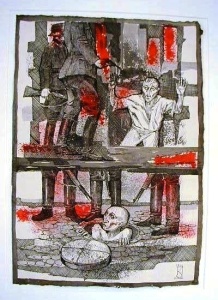
The paintings are divided into four equal sections: Exodus that depicts the shock, humiliation and persecution of Polish Jewry after the German invasion; Ghetto describes the incredible suffering of ghetto life; Ghetto Fighting documents the fierce resistance Jews mounted and finally Massacre forces us to witness the capture, murder and/or deportation of the Warsaw Ghetto Jews. While many of the images are based on existing documentary photographs of ghetto conditions, the final section, Massacre, was largely based on the infamous Stroop Report, a Nazi written and photographic record of the brutal liquidation and destruction of the ghetto in April 1943.
While there are other examples of post-Holocaust art by non-Jews, I believe this is a exceptional if not singular example of works about Jewish victims among Polish artists. Considering its ambitious scale, complex narrative structure and seriousness of the works, it expresses a rarely seen heartfelt politics of empathy.
Significantly this Kestenbaum June 20th auction provides more than just the occasion to own some very noteworthy Judaica; it gives us the opportunity to ponder many of the meaningful challenges of the ideas that quality Judaica and Jewish art can present.
212 366 1197 www.Kestenbaum.net